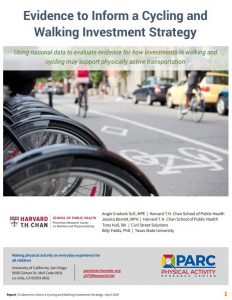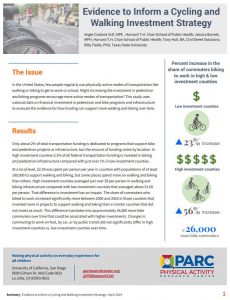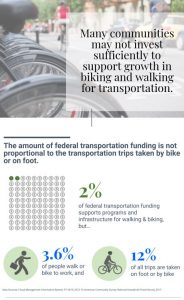Harvard T.H. Chan School of Public Health
Evidence to Inform a Cycling and Walking Investment Strategy
Description
 Fewer than 1 in 4 adults in the U.S. use physically active modes of transportation like walking or bicycling. Getting more people to walk or bike instead of drive for transportation may be a cost-effective and sustainable strategy to increase population physical activity and improve health. To reach that goal, communities need clear, practical guidance for investments that can promote more active transportation.
Fewer than 1 in 4 adults in the U.S. use physically active modes of transportation like walking or bicycling. Getting more people to walk or bike instead of drive for transportation may be a cost-effective and sustainable strategy to increase population physical activity and improve health. To reach that goal, communities need clear, practical guidance for investments that can promote more active transportation.
This project will collect data to try to answer several questions, including:
- How much funding for local programs and infrastructure does it take to increase active transportation levels?
- Is there evidence for different levels of funding for local programs and infrastructure resulting in shifts in transportation mode?
- Does the level of investment needed differ by community type (e.g., rural, suburban, urban areas) or economic status?
To try to answer these questions, researchers will combine data on investments in bicycle and pedestrian projects and programs with US Census data on the transportation modes used by residents in communities across the country. They also will consult with contacts involved in large-scale programs that have been funded to improve rates of walking and bicycling, as well as transportation leaders in communities that have experienced gains in physically active transportation over time. These stakeholder interviews will explore the potential impacts of policies or other non-monetary considerations and inform the development of communications products.
Communication Plan/Projected Products
 Key stakeholders for communication include the Federal Highway Administration, state and local transportation coordinators, and public health and transportation advocates. The research team plans to communicate key learnings via a policy brief with web-based media materials and a research article with detailed analysis and project results. Web-based materials and information policy briefs will be used to educate and promote discussion among decision makers, transportation/planning professionals, and advocates. Materials will highlight the key findings and policy implications of the research for these audiences, to promote the implementation of best practices for successful and supportive active transportation programs. A research article in a transportation-focused journal will highlight the key findings for transport professionals. The team expects to identify partners for key dissemination activities defined according to audience/sector (i.e., planner, decision maker, advocate), mode (e.g., presentation/briefing, listserv) and materials (e.g., printed media) via online/social media networks of key stakeholders.
Key stakeholders for communication include the Federal Highway Administration, state and local transportation coordinators, and public health and transportation advocates. The research team plans to communicate key learnings via a policy brief with web-based media materials and a research article with detailed analysis and project results. Web-based materials and information policy briefs will be used to educate and promote discussion among decision makers, transportation/planning professionals, and advocates. Materials will highlight the key findings and policy implications of the research for these audiences, to promote the implementation of best practices for successful and supportive active transportation programs. A research article in a transportation-focused journal will highlight the key findings for transport professionals. The team expects to identify partners for key dissemination activities defined according to audience/sector (i.e., planner, decision maker, advocate), mode (e.g., presentation/briefing, listserv) and materials (e.g., printed media) via online/social media networks of key stakeholders.
Research Findings and Products
- Evidence to Inform a Cycling and Walking Investment Strategy – The 12-page full report (PDF) uses national data on financial investment in pedestrian and bike programs and infrastructure to evaluate the evidence for how funding can support more walking and biking over time. A 2-page lay summary (PDF) and infographic (PDF) highlighting the main findings from the full report are also available.
Project Team
Angie Cradock ScD, MPE – Principal Investigator
– Principal Investigator
Jessica Barrett, MPH – Project Data Manager and Analyst
Molly Knox, MA – Project Communications Associate
Tony Hull, BA – Independent Consultant on Nonmotorized Transportation, Project Advisor
Billy Fields, PhD – Texas State University, Project Advisor
